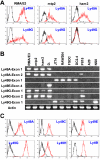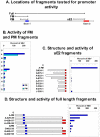Comprehensive analysis of transcript start sites in ly49 genes reveals an unexpected relationship with gene function and a lack of upstream promoters
- PMID: 21483805
- PMCID: PMC3069108
- DOI: 10.1371/journal.pone.0018475
Comprehensive analysis of transcript start sites in ly49 genes reveals an unexpected relationship with gene function and a lack of upstream promoters
Abstract
Comprehensive analysis of the transcription start sites of the Ly49 genes of C57BL/6 mice using the oligo-capping 5'-RACE technique revealed that the genes encoding the "missing self" inhibitory receptors, Ly49A, C, G, and I, were transcribed from multiple broad regions in exon 1, in the intron1/exon2 region, and upstream of exon -1b. Ly49E was also transcribed in this manner, and uniquely showed a transcriptional shift from exon1 to exon 2 when NK cells were activated in vitro with IL2. Remarkably, a large proportion of Ly49E transcripts was then initiated from downstream of the translational start codon. By contrast, the genes encoding Ly49B and Q in myeloid cells, the activating Ly49D and H receptors in NK cells, and Ly49F in activated T cells, were predominantly transcribed from a conserved site in a pyrimidine-rich region upstream of exon 1. An ∼200 bp fragment from upstream of the Ly49B start site displayed tissue-specific promoter activity in dendritic cell lines, but the corresponding upstream fragments from all other Ly49 genes lacked detectable tissue-specific promoter activity. In particular, none displayed any significant activity in a newly developed adult NK cell line that expressed multiple Ly49 receptors. Similarly, no promoter activity could be found in fragments upstream of intron1/exon2. Collectively, these findings reveal a previously unrecognized relationship between the pattern of transcription and the expression/function of Ly49 receptors, and indicate that transcription of the Ly49 genes expressed in lymphoid cells is achieved in a manner that does not require classical upstream promoters.
Conflict of interest statement
Figures








Similar articles
-
The distal upstream promoter in Ly49 genes, Pro1, is active in mature NK cells and T cells, does not require TATA boxes, and displays enhancer activity.J Immunol. 2015 Jun 15;194(12):6068-81. doi: 10.4049/jimmunol.1401450. Epub 2015 Apr 29. J Immunol. 2015. PMID: 25926675 Free PMC article.
-
Identification of a novel Ly49 promoter that is active in bone marrow and fetal thymus.J Immunol. 2002 May 15;168(10):5163-9. doi: 10.4049/jimmunol.168.10.5163. J Immunol. 2002. PMID: 11994471
-
Comparative analysis of the promoter regions and transcriptional start sites of mouse Ly49 genes.Immunogenetics. 2001 Apr;53(3):215-24. doi: 10.1007/s002510100313. Immunogenetics. 2001. PMID: 11398966
-
Regulation of class I major histocompatibility complex receptor expression in natural killer cells: one promoter is not enough!Immunol Rev. 2006 Dec;214:9-21. doi: 10.1111/j.1600-065X.2006.00452.x. Immunol Rev. 2006. PMID: 17100872 Review.
-
Inhibitory Ly49 receptors on mouse natural killer cells.Curr Top Microbiol Immunol. 2011;350:67-87. doi: 10.1007/82_2010_85. Curr Top Microbiol Immunol. 2011. PMID: 20680808 Review.
Cited by
-
Natural killer cell inhibitory receptor expression in humans and mice: a closer look.Front Immunol. 2013 Mar 26;4:65. doi: 10.3389/fimmu.2013.00065. eCollection 2013. Front Immunol. 2013. PMID: 23532016 Free PMC article.
-
Analysis of Ly49 gene transcripts in mature NK cells supports a role for the Pro1 element in gene activation, not gene expression.Genes Immun. 2016 Sep;17(6):349-57. doi: 10.1038/gene.2016.31. Epub 2016 Jul 28. Genes Immun. 2016. PMID: 27467282 Free PMC article.
-
Differential Expression of Ccn4 and Other Genes Between Metastatic and Non-metastatic EL4 Mouse Lymphoma Cells.Cancer Genomics Proteomics. 2016 11-12;13(6):437-442. doi: 10.21873/cgp.20006. Cancer Genomics Proteomics. 2016. PMID: 27807066 Free PMC article.
-
The distal upstream promoter in Ly49 genes, Pro1, is active in mature NK cells and T cells, does not require TATA boxes, and displays enhancer activity.J Immunol. 2015 Jun 15;194(12):6068-81. doi: 10.4049/jimmunol.1401450. Epub 2015 Apr 29. J Immunol. 2015. PMID: 25926675 Free PMC article.
-
Binary outcomes of enhancer activity underlie stable random monoallelic expression.Elife. 2022 May 26;11:e74204. doi: 10.7554/eLife.74204. Elife. 2022. PMID: 35617021 Free PMC article.
References
-
- Yokoyama WM, Plougastel BF. Immune functions encoded by the natural killer gene complex. Nat Rev Immunol. 2003;3:304–316. - PubMed
-
- Dimasi N, Biassoni R. Structural and functional aspects of the Ly49 natural killer cell receptors. Immunol Cell Biol. 2005;83:1–8. - PubMed
-
- Raulet DH, Held W, Correa I, Dorfman JR, Wu MF, et al. Specificity, tolerance and developmental regulation of natural killer cells defined by expression of class I-specific Ly49 receptors. Immunol Rev. 1997;155:41–52. - PubMed
-
- Held W, Kunz B. An allele-specific, stochastic gene expression process controls the expression of multiple Ly49 family genes and generates a diverse, MHC-specific NK cell receptor repertoire. Eur J Immunol. 1998;28:2407–2416. - PubMed
-
- Takei F, McQueen KL, Maeda M, Wilhelm BT, Lohwasser S, et al. Ly49 and CD94/NKG2: developmentally regulated expression and evolution. Immunol Rev. 2001;181:90–103. - PubMed
Publication types
MeSH terms
Substances
Grants and funding
LinkOut - more resources
Full Text Sources

